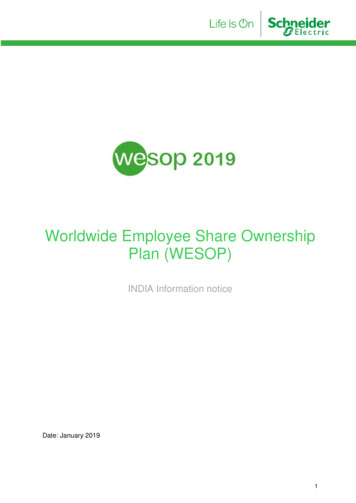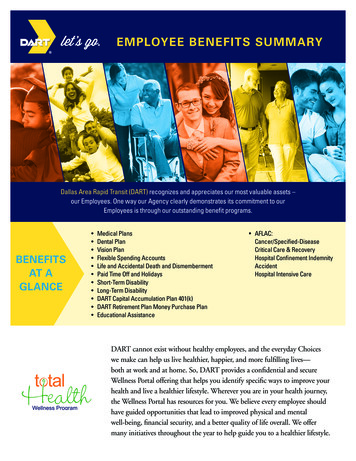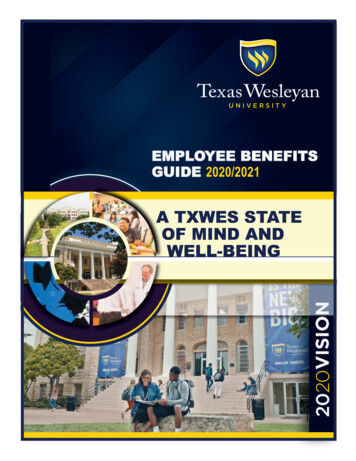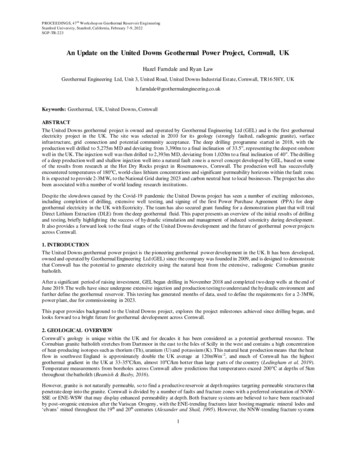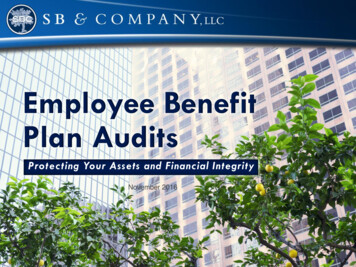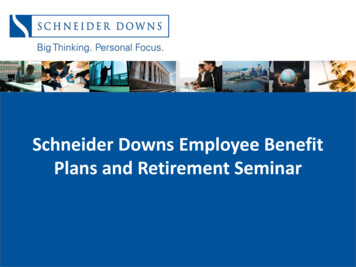
Transcription
Schneider Downs Employee BenefitPlans and Retirement Seminar
Schneider Downs offers more than 80 unique servicesfrom five distinct business units
Schneider Downs offers more than 80 unique servicesfrom five distinct business unitsAuditTaxBusiness AdvisorsWealth Management Financial Statement Audit Review and Compilation SEC Internal AuditCo-Sourcing/ Outsourcing ERISA Traditional Compliance International State and Local Tax Tax Accounting/FIN48 Employee Benefits Cost Segregation Co-Sourcing/Outsourcing ProductivityImprovement Business Valuation Forensic Accounting/Litigation Support Transaction AdvisoryServices 401(k) Plan Management High Net WorthCorporate FinanceTechnology Mergers and Acquisitions Buy Side Corporate Finance Sell Side Software Solutions Process Reengineering Security Vulnerability Software Selection Internal ControlAssessment Review of OngoingTechnology OperationsSchneider DownsStaffingSchneider DownsMeridian Permanent Staffing Temporary Staffing Performance Improvement Turnaround/Restructuring Insolvency Services Debt Placement3
Our Thoughts On Sign up today to receive our newsletters,which contain timely content on a variety ofaccounting, tax, business advisory and other updates:www.schneiderdowns.com/subscribe
Connect with Schneider DownsFacebook: facebook.com/schneiderdownsTwitter: @Schneider DownsLinkedIn: linkedin.com/company/schneider-downsPlease visit our website: www.schneiderdowns.com
Please Complete Your Evaluation FormPlease complete and return your evaluationsto the Schneider Downs registration desk after the event.We greatly appreciate the feedback on today’s session,as well as ideas for future topics.
AgendaWelcomeJeanne M. BarrettSchneider Downs & Co., Inc.Compensation Considerations for Retirement PlanDonna WolfsonSchneider Downs & Co., Inc.Prepare Now – Avoiding Benefit Plan PitfallsLauren Crossett & Jennifer GardnerCohen & GrigsbyFiduciary Litigation Update and Best Practices to Avoid ExposureScott RainSchneider Downs & Co., Inc.Ask the Expert Panel DiscussionJeanne BarrettLauren CrossettJennifer GardnerTodd Lucas – Schneider Downs & Co., Inc.Jason Lumpkin – Schneider Downs & Co., Inc.Donna Wolfson7
Professional Credits 2 CPE credits – Specialized Knowledge 2 HRCI credits All certificates will be available at the end of theseminar.8
Handouts for Today’s EventMaterials for today’s eventwill be available fits-forum9
COMPENSATION CONSIDERATIONS FORRETIREMENT PLANSPresented by:DONNA L. WOLFSON, QPA, QKARETIREMENT ADMINISTRATION SPECIALIST412-697-5608 dwolfson@schneiderdowns.com
The IRS states that compensation mistakes are one of the most common, if not themost common, errors found upon plan examination.Specifically, it’s the failure to use the correct definition of compensation as defined inthe Plan document.11
Why is compensation so important? It permeates every aspect of qualified retirement plan administration. The important lesson to take away from today is: Make sure you are using thecorrect definition of compensation, and make sure that your plan is beingoperated in accordance with that definition.12
Consequences of using the wrong definition ofcompensation Affects the participants’ retirement benefits, whether it be account balances in a 401(k)or profit sharing plan or the accrued benefits in a defined benefit plan Affects the amount of participants’ salary deferrals under a Section 401(k) Plan (if thedeferral is based on a percentage of compensation) Affects the amount participants will receive in employer profit sharing or matchcontributions in a defined contribution plan Affects the minimum required funding amount an employer must contribute to adefined benefit plan Affects the outcome of required non-discrimination testing, whereby the test “fails”when it actually passes or it “passes” when in reality it fails13
Safe Harbor Definitions of Compensation The Plan document (or the Plan Adoption Agreement) defines “compensation.” Most likely, the plan document will describe compensation as one of these three basic“safe harbor” definitions of compensation:– W-2 compensation (usually Box 1)—wages plus any taxable portion of insurance premiums (PS58 costs), use of company car / phone and any other taxable fringe benefits– IRC Section 3401(a) compensation (federal income tax withholding wages)—tax withholding atits source; think of it in terms of salary and / or bonuses, commissions, etc.– Section 415 safe harbor compensation—most simplistic definition is 3401(a) / W-2 comp plusmost fringe benefits; i.e., any income received from the company14
Safe Harbor Definitions of Compensation Interestingly, W-2 and 3401(a) compensation excludes “elective deferrals,”whereas 415 compensation includes elective deferrals. Since W-2 /3401(a) compensation are the most common definitions found in plandocuments, we’ll limit our discussion to these15
Why so many compensation errors? Failure to read and / or understand the Plan document Errors can occur when new payroll codes are implemented or there’s a personnelchange and the plan’s definition of compensation is not properly communicated Failure to communicate with your Third-Party Administrator (TPA) to ensure thatthe correct definition of compensation is being used Where the IRS is concerned, nothing is simple, and the basic definition ofcompensation is not so basic– The plan document describes additional compensation that is included or excluded fromthe “safe harbor” definition of compensation16
Inclusions / Exclusions from the definition of compensation The plan document doesn’t just define compensation as “W-2” or “3401(a)”compensation. Closer reading will reveal inclusions and exclusions from thedefinition of compensation. Most common “inclusion” of compensation that is “excluded” from W-2 / 3401(a)compensation are pre-tax deferrals, not just the 401(k) deferrals, but also any pretax deferrals to a Section 125 Cafeteria plan or Section 132 (f) transportation plan17
Inclusions / Exclusions from the definition of Compensation Another common “exclusion” is what is known as “date of participation,”compensation– could be expressed as “compensation prior to determination period is excluded”– all references to Compensation are identified as “participant” as opposed to “employee” The plan document could exclude overtime / bonuses / commissions from thedefinition of compensation Some plan documents will include or exclude other “fringe benefits” from thedefinition of compensation (such as car allowances, moving expenses)18
Other Compensation Issues Failure to take into consideration the maximum allowable consideredcompensation on which to base all retirement plan contributions (401(a)(17)limit)—for 2017, it’s 270,000 Failure to recognize that the maximum total contribution (deferrals plus employercontributions) is limited to the lesser of 25% of a participant’s eligiblecompensation or the maximum dollar amount in effect for the plan year ( 54,000for 2017)—if a participant is over age 50, entitled to an additional 6,000maximum dollar amount19
Other Compensation Issues Some plan documents use different definitions of compensation for 401(k) deferrals,employer match contributions and employer profit sharing contributions Calendar-Year vs Fiscal-Year Plans (off Calendar-Year Plan)– Compensation is usually based on the plan year, so calendar-year plans make it easy (easier) todetermine compensation– Fiscal-Year Plans: Compensation is usually (but not always) based on the Plan Year; for a PlanYear that runs from 7/1-6/30, compensation would be based on earnings coinciding with theplan year If entity is a partnership or an LLC treated as a partnership, or if it’s a sole proprietor,the partner’s or sole proprietor’s compensation will be based on “earned income” (K-1income for partners; Schedule C income for sole proprietors)20
Other Compensation Issues Post-severance compensation (Final Paycheck Rule)– the payment is regular compensation for services rendered prior to termination ofemployment, but paid after severance from employment– includes payment for unused accrued bona fide sick, vacation or other leave that theemployee would have been able to use if employment had continued– paid later of 2 ½ months following termination of employment or the last day of the plan yearin which the employee severed employment– included as compensation in the year in which it is paid– Severance pay is never considered as compensation for plan purposes (deferrals, match, PS)21
Other Compensation Issues Post year-end compensation– Compensation earned in one year but actually paid early in the following year, such ascommissions, will be considered compensation in the year it was earned– Must be paid within the first few weeks (generally first payroll) of the new year Defined benefit plans have additional compensation considerations– In a DBP, your benefit is based on what’s called your “accrued benefit” (AB)– AB generally is based on Average Monthly Compensation (or Average AnnualCompensation) multiplied by years of service (or years of participation)22
Other Compensation Issues Defined benefit plans have additional compensation considerations– DBP’s contain the same “main” definition of comp--W-2, 3401(a), etc. plus anyexclusions/ inclusions as in a 401(k) plan– The plan document also will define what is meant by “Average Monthly Compensation”(AMC) or “Average Annual Compensation” (AAC) to calculate the Accrued Benefit (thebenefit to which the participant is entitled, as opposed to an account balance in a 401(k)Plan– To ensure that the actuary properly calculates the participants’ accrued benefits, youmust ensure that the correct definition of compensation and the correct definition ofAMC /AAC are being used.23
Conclusion Example of compensation errors found in IRS examination24
PREPARE NOW—AVOIDING BENEFITPLAN PITFALLS IN CORPORATETRANSACTIONSJennifer M. Gardner / jgardner@cohenlaw.comLauren M. Crossett / lcrossett@cohenlaw.comCOHEN & GRIGSBY, P.C.Employee Benefits & Executive Compensation Group
IntroductionPart I: Overview of Sale & Diligence ProcessPart II: Potential Benefit Plan Issues &Corrections
Anatomy of a Merger or AcquisitionStep 1:Buyer identifies Target Company to acquireStep 2:Parties agree to Structure (stock, merger,or asset sale)Step 3:Parties engage in Due DiligenceStep 4:Negotiate Terms of Purchase AgreementStep 5:Signing & Closing
Structure of the TransactionImportant: What’s the Form of the Transaction? Treatment of plans and employees Scope of diligence Three Options: Stock sale Asset sale Merger Structure is driven by liability, tax, and other factorsgenerally (although not always) unrelated to benefits
Due DiligencePurposes & Goals Understand target’s ERISA plans and employeebenefit obligations Determine potential liabilities Design benefits structure post-closing
Due DiligenceWhat to Expect Electronic data room Multiple phases Initial, comprehensive request list Follow-up requests Scope of diligence could depend on the structure ofthe transaction
Due Diligence ProcessBest Practices Assign a main benefits contact to be the point personon all diligence matters Provide accurate and thorough initial responses Ensure all plans are identified initiallyProvide all compliance, communication, and filinginformation (i.e., SARs, SBCs, Form 5500s), subject tomateriality limitationsWork with an ERISA attorney early and often
Negotiating the Purchase AgreementRepresentations and Warranties Seller’s enforceable promise regarding compliance of plansand the absence of certain material liabilities Generally negotiated and reviewed by the attorneys,sometimes with interaction with the owners andmanagement, but based on information and answersprovided by HR/Benefits/Accounting Exceptions must be listed on “Disclosure Schedules” Buyer might require correction, before or after closingPossible first-dollar indemnification for costs and liabilities
Areas of LiabilitySignificant Liability Red Flags Underfunded pension plans Multiemployer (union) plans Retiree medical obligationsCommon Liabilities Plan document errors Operational errors Compliance errors
Common Retirement Plan ErrorsCommon Error #1: Document Errors Signed documents, amendments, & trust agreements Amendments timely adopted and implemented Accuracy/consistency of related documents Favorable IRS determination letter or opinion letter(pre-approved plans)
Common Retirement Plan ErrorsCommon Error #2: Delinquent Contributions Late deposit of employee contributions & loanpayments Need full correction (base contributions plusearnings) Identified on Form 5500 and Audit Report VFCP filing to avoid prohibited transaction penalties
Common Retirement Plan ErrorsCommon Error #3: Plan Eligibility Errors Not following the plan’s terms Improperly excluded part-time or temporaryemployees Improperly classified independent contractors andleased employees
Common Retirement Plan ErrorsCommon Error #4: Missed or Late Correction ofADP/ACP Testing Failures Assuming a calendar year plan: Must be corrected by March 15 of the following yearto avoid excise tax (extension for certain EACAs) Must be corrected by December 31 of the followingyear to avoid a qualification error
Common Retirement Plan ErrorsCommon Error #5: Plan Fiduciary Issues Someone has fiduciary liability for the plan Discretionary authority for investments and other decisionsLack of formal delegation irrelevantBest practice Fiduciary committee tasked with oversight and decisionmaking authority for discretionary and investment decisions(formal delegation and charter)Fiduciary liability insurance
Common Retirement Plan ErrorsCommon Error #6: Controlled Group Errors May result in a failure to properly include or excludeemployees of related employers Plan Documentation Participating Employer Status Standardized Prototype Plan Document Minimum Coverage Testing Multiple Employer Plans
Common Nonqualified Plan Errors Operational and documentary compliance is critical Know your nonqualified plans (not just SERPs, butalso equity arrangements, AIPs and LTIPs, executivelife insurance, and even some individualizedexecutive arrangements) 409A compliance 280G triggers
Common Welfare Plan Errors Plan documents (ERISA wrap document, SPDs, andCode Section 125/cafeteria plan) ACA compliance (coverage & reporting) Self-insured plans and nondiscrimination rules Form 5500 filings No ineligible participants
Preparing for a Sale (Sell-Side) Internal compliance check Compile all current, signed documents Available IRS and DOL correction programs: EPCRS VFCP DFVCP Take charge of your own corrections when you havethe ability to focus on them – before a buyer hasinput!
Questions?Jennifer M. GardnerCohen & Grigsby, P.C.(412) 297-4619jgardner@cohenlaw.comLauren M. CrossettCohen & Grigsby, P.C.(412) 297-4750lcrossett@cohenlaw.com
Best Practices For Managing FiduciaryObligations Under Retirement PlansPresented by:Scott R. Rain, J.D.Schneider Downs & Co., IncSchneider Downs Wealth Management Advisors, LPSDAdvantage Retirement Plan Solutions, LP
ERISAEmployee Retirement Income Security Act of 1974 FICUCIARIES-Who? FIDUCIARY DUTY-What? Authorizes employees to sue for breach Generally applies to both 401(k) plans and 403(b) plans45
ERISA WHO?– Persons with responsibility for engaging service providers or appointing fiduciaries (EmployerPlan Sponsor Board of Directors Committee)– Named Fiduciaries including the Trustee, ERISA 3(21) or 3(38) fiduciaries– Any person who has discretionary authority or control over the plan or plan assets orover the administration of the plan.46
ERISADUTIES–––PRUDENCE Prudent Man Standard- “.discharge duties .with the care, skill, prudence and diligence underthe circumstances then prevailing that a prudent man, acting in a like capacity and familiar withsuch matters would use ”Engagement of professional advisors- Things to know: Information about the firm itself: affiliations, financial condition, experience with 401(k) plans,and assets under their control; A description of business practices: how plan assets will be invested if the firm will manageplan investments or how participant investment directions will be handled, and proposed feestructure; Information about the quality of prospective providers: the identity, experience, andqualifications of the professionals who will be handling the plan’s account; any recent litigationor enforcement action that has been taken against the firm; the firm’s experience orperformance record; if the firm plans to work with any of its affiliates in handling the plan’saccount; and whether the firm has fiduciary liability insurance.Remember it is about the PROCESS (not the results); therefore, document the process and theimplementation of process47
ERISABasic Responsibilities/Duties – Those persons or entities that are fiduciaries are in aposition of trust with respect to the participants and beneficiaries in the plan. Thefiduciary’s responsibilities include:– Acting solely in the interest of the participants and their beneficiaries;– Acting for the exclusive purpose of providing benefits to workers participating in theplan and their beneficiaries, and defraying reasonable expenses of the plan;– Carrying out duties with the care, skill, prudence, and diligence of a prudent personfamiliar with such matters;– Following the plan documents; and– Diversifying plan investments.48
Summary of Litigation Issues RECORDKEEPING– Asset-based (basis point % charge) fees versus per participant fixed fee– Multiple Recordkeepers– Revenue Sharing– Proprietary Funds with a Focus on Stable Value vs. Money Market– Ongoing Process to Monitor Fees and Services49
Summary of Litigation Issues INVESTMENT-BASED CLAIMS– Duplicative, Excessive and High-Cost Options Multiple funds in each asset class Lowest cost available share class Cost/Return analyses Failure to provide passive/index options Structure-mutual fund, annuity, separate account or CIT’s– Capital Preservation Fund- Stable Value Fund vs. Money Market– Self-dealing– Failure to have or follow a documented process to monitor and replace investmentoptions (Investment Policy Statement)50
Best Practices - Fiduciary Structure Professional Fiduciary – 3(38) and/or 3(21)A 3(21) investment fiduciary is a paid professional who provides investment recommendations to theplan sponsor/trustee. The plan sponsor/trustee retains ultimate decision-making authority for theinvestments and may accept or reject the recommendations.By properly appointing and monitoring an authorized 3(38) investment manager, a plan sponsor/trusteeis relieved of all fiduciary responsibility for the investment decisions made by the investmentprofessional. Naming the appropriate Committee Members – education and experience Protections––Fiduciary Liability InsuranceCorporate/Organizational Indemnification51
Best Practices- Investment Policy Statement (IPS) WHO? Identify fiduciaries and non-fiduciary advisors WHAT? Identify asset classes HOW? Fund selection and monitoring procedures Periodically review52
Best Practices – Investment Selection and Monitoring Performance vs. BenchmarksAsset Class Identification/Style DriftExpense Relative to Peers and BenchmarksRevenue Sharing StrategyTransfer RestrictionsShare Class OptimizationActive vs. Indexing Strategy and UtilizationCapital Preservation Fund Strategy - Stable Value vs. Money Market53
Best Practices- Recordkeeping Monitoring Periodic RFP Process Benchmarking of Fees Evaluation of Services and Service Delivery Asset-Based vs. Per-Participant Fixed Fees Revenue Sharing - Understand and Measure Application and Utilization54
Recommendations Consider an independent “Fiduciary Check-Up” Consider conducting an RFP or a Fee Benchmarking Study Contact me or your SD representative for more informationScott R. Rainsrain@schneiderdowns.com(412) 697-531555
DISCLOSUREMaterial discussed is meant for general illustration and/orinformational purposes only and it is not to be construed asinvestment, tax or legal advice. Although the information hasbeen gathered from sources believed to be reliable, please notethat individual situations can vary. The information providedshould be relied upon when coordinated with individualprofessional advice.56
Ask the Experts - Panel Discussion
Thank you for attending!
58 costs), use of company car / phone and any other taxable fringe benefits - IRC Section 3401(a) compensation (federal income tax withholding wages)—tax withholding at its source; think of it in terms of salary and / or bonuses, commissions, etc.


